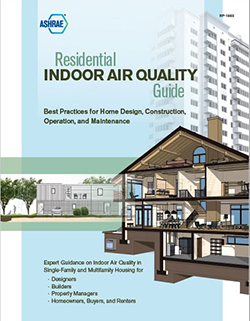New Guide Addresses Best Practices to Achieve Excellent IAQ in Residences
From eSociety, June 2018
Achieving good IAQ throughout the lifespan of a home requires a commitment to indoor air quality when buying, renting, and designing and maintaining that focus throughout construction, operation and maintenance.
Residential Indoor Air Quality Guide: Best Practices for Home Design, Construction, Operation, and Maintenance addresses single- and multifamily dwellings, unrestricted by building size or HVAC system type. The guide addresses residential dwelling units covered by ASHRAE Standard 62.2, Ventilation and Acceptable Indoor Air Quality in Low-Rise Residential Buildings.
Written by Lawrence J. Schoen, Terry Brennan, Amy Musser and Armin Rudd and published by ASHRAE, the guide includes best practices to achieve excellent IAQ and information and tools that residents, home designers and builders can use to integrate IAQ into dwellings.
“That’s not to say it’s watered down. It also has some pretty serious material in there for architects and engineers who are designing single-family or multi-family homes,” said Schoen, P.E., Fellow ASHRAE.

While information on residential IAQ can be found on the Internet and other venues, this guide compiles the latest credible information into a single publication to counter misinformation, Schoen said.
One misconception centers around ways to use low-cost sensors to measure IAQ, he said. Schoen said he would not put absolute faith in the absolute IAQ measurements from inexpensive devices, but those sensors can alert residents when they are doing activities that are high polluting.
Another misconception the guide addresses is the use of plants to improve IAQ. Houseplants improve aesthetics, but they do not improve IAQ, Schoen said.
Keeping a home air and watertight, having good dehumidification and other strategies do improve IAQ, he said.
“Tightening up home for energy conservation also is compatible with indoor air quality, provided there’s additional ventilation,” Schoen said.
This guide presents information to guide informed decision-making, with eight objectives for improving IAQ and detailed implementation strategies:
- Acquire, Design, Construct and Operate a Dwelling to Achieve Good IAQ
- Manage Moisture
- Limit Contaminant Entry into the Living Space
- Control Moisture and Contaminants Related to Mechanical Systems
- Limit Contaminants from Indoor Sources
- Keep Contaminants in their Place
- Reduce Contaminant Concentrations Through Ventilation, Filtration, and Air Cleaning
- Minimize Energy Use, Maximize Comfort, and Address Interactions of Factors that Affect IAQ
Schoen said residential buildings are built differently than commercial and institutional buildings. To provide credible information to builders, the guide includes guidance for builders who are looking to build “ordinary” projects as well as information for projects that want to take a step further into improving IAQ, he said.
The guide was written for the following audiences:
- Homeowners and renters who might choose a dwelling and/or its custom features or work with designers to build a dwelling from scratch and who can choose materials, products and activities that improve or at least do not reduce IAQ.
- Architects, home designers and builders who can apply the recommended practices during design, construction and renovation.
- Developers of multifamily building (e.g., duplex, rowhouse, or low- or high-rise apartment or condominium) projects and other decision makers who direct the work of the above professionals.
- Home energy raters and commissioning authorities who determine whether design elements, construction observation, functional testing and the finished dwelling meet IAQ-related goals and requirements.
- Organizations with sustainable building rating programs and/or that conduct training for these programs.
- Indoor environmental professionals who seek a broader understanding of residential building practice to better serve their clients’ concerns about their home IAQ.
- Multifamily building managers and operators who need to understand the IAQ implications HVAC systems and operations and maintenance practices.